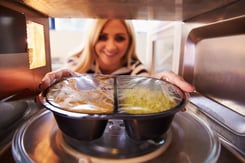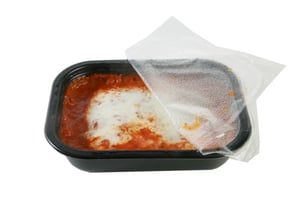 Remember when we wrote the blog, “When it Comes to Material Selection, Not All Plastics are Created Equal?” Well this sentiment is especially true when it comes to selecting materials for food packaging applications that will undergo high heat conditions such as the microwave. Throwing a plastic container in the microwave for a couple of minutes or even the act of pouring a hot soup into a container that is not intended to withstand high heat conditions could be enough to warp the container and damage the contents.
Remember when we wrote the blog, “When it Comes to Material Selection, Not All Plastics are Created Equal?” Well this sentiment is especially true when it comes to selecting materials for food packaging applications that will undergo high heat conditions such as the microwave. Throwing a plastic container in the microwave for a couple of minutes or even the act of pouring a hot soup into a container that is not intended to withstand high heat conditions could be enough to warp the container and damage the contents.
Advancements in polymer technology have extended the operating temperature range of plastic materials so that certain resins can now withstand colder and hotter conditions than ever before. However, during the product development stage, if there is a chance that the packaging could undergo high heat conditions such as the microwave, the temperature profiles of different resin materials should be considered to ensure that the packaging will maintain it’s integrity and keep the food safe.
Polyethylene Terephthalate (PET)
PET is the most commonly used plastic material for consumable bottled liquids, such as soft drinks and bottled water, condiments, and other food products. It’s also used extensively in rigid food packaging applications due to its attractive price point and excellent clarity. The typical operating temperature of PET maxes out around 160°F, while the typical microwave heats the food up to around 212 °F. As a result, this material is not recommended for microwave or high heat / hot-fill packaging and processing applications, as the presence of high heat can cause the material to warp or the package to melt. For this reason you will see a clear PET container at the salad bar and not at the soup counter. In addition, PET containers are meant for single use, and are not intended for applications where re-heating or re-use is a requirement.
 PP has a high heat tolerance, making it the ideal material for packaging hot food or foods that require microwaving. This is due to PP’s high melting point - PP’s operating temperature range goes up to 295°F, with a microwavable & hot fill temperature of up to approximately 260°F. In addition, PP materials are generally considered safe for re-use and can be re-heated - so for applications such as pre-made meals or takeout containers, this material is ideal.
PP has a high heat tolerance, making it the ideal material for packaging hot food or foods that require microwaving. This is due to PP’s high melting point - PP’s operating temperature range goes up to 295°F, with a microwavable & hot fill temperature of up to approximately 260°F. In addition, PP materials are generally considered safe for re-use and can be re-heated - so for applications such as pre-made meals or takeout containers, this material is ideal.
It is important to note, however, which grade of PP you plan to use. There are three main grades of PP resin used today – homopolymer, random copolymer, and block (or impact) copolymer. Typically, homopolymer and block copolymer PP resins are better suited for high heat applications than a random copolymer. Furthermore, if the intention of the packaging is to go from a freezer to a microwave, a block copolymer will give the packaging better impact resistance a low temperatures than a homopolymer, ensuring that the packaging will not crack.
Click here to learn more about the three main grades of polypropylene in our blog post!
In food packaging, PP has typically been reserved for hot applications as its natural, milky or hazy appearance, is not ideal for applications that require consumer appeal. This has change, however, with the introduction of UltraClear Polypropylene, which allows for versatility among hot and cold applications without having to compromise on aesthetics.
Filled PP sheet products such as calcium carbonate filled polypropylene sheet or talc filled polypropylene sheet are commonly used in food packaging applications because the addition of mineral fillers allows this material to better combat temperature changes. The incorporation of both calcium carbonate and talc to this material results in an increased resistance to heat and better cooling characteristics. In addition, studies have shown calcium carbonate mineral filler to have increased success at higher loading levels. Impact Plastics has extrusion systems in place for mineral filler blending and has the capability to produce sheet with a mineral filler loading up to 40%.
PS is seen most often in Styrofoam cups and meat trays, and in rigid packaging applications. The operating temperature of this material maxes out at around 185°F. As noted above, the typical microwave heats a food product up to around 212 °F. So while PS should not be put in the microwave, the maximum operating temperature suggests that this material can withstand a slightly lower heat than that of a microwave. However, it is important to note that if a hot item does come in a PS packaging, it is likely only intended for single-use only.
Impact Plastics recommends that our customers complete testing of all materials to ensure that the material meets the desired requirements of their application. To learn more about how our products can work with your application, click on the link to the left to talk to our team today!




